Text & photographs by Dr. Mahadeswara Swamy, Scientist
Among the innumerable plants used in native system of medicines ‘Aparajita’ stands out as a curative herb to improve memory. In Ayurveda, it is grouped under ‘Medhya’ category forming part of “Shirovirechanopaga” group of herbs associated with detoxification and cleansing of the brain and associated nervous system. A perennial creeper known as ‘Shanku pushpa’ in Kannada, it is often seen in the backyards of Indian household. (English: ‘Butterfly pea’, Asian pigeon-wings, bluebell-vine, blue pea, cordofan pea and Darwin pea; Hindi: Aparajita, Gokarni, Khagtu; Kannada: Aparajite, Girikarnike, Kantisoppu, Gokarna; Malayalam: Sangu pushpam; Marathi: Gokarna, Shankha pushpa; Sanskrit: Aparajita, Girikarnika, Ghrstih; Tamil: Kakkanam, Kakkattan Kannikkodi, Uyvai; Telugu: Gentana, Sankhu-pushpamu).
The scientific name is Clitoria ternatea of Fabaceae family. The genus name “Clitoria”, from the Latin name “Clitoris” is due to its petals resembling human female genitals (yoni). It is native to Africa & South East Asia and widely cultivated in India, South America and Australia.
Description
Clitoria ternatea is a vigorous, trailing, scrambling or climbing vine with a strong woody rootstock. Stems are sparsely hairy, sub-erect and produce slender new stems from the woody base each year. The leaves are compound with 5-7 leaflets, elliptical, 3-5 cm long. The flowers are solitary or paired, blue or white, about 1 to 1.5 inches with bract and bracteole (leafy structures on the stalk subtending the petiole); petals varying in colour (vivid deep / cobalt blue or light blue with a white throat or pure white), standard large, emarginated, wings oblong, keel incurved with a yellow to white pattern in the centre of the lower petal. Stamens 10 ( 9 fused to form a tube+ 1 free) . Ovary elongated, densely clothed in white hairs. Fruits are flat, linear, sparsely pubescent pods dehiscing violently at maturity throwing 8-10 dark shiny seeds.
There are many ecotypes, agro-types and cultivars with variations in flowers and leaflets.
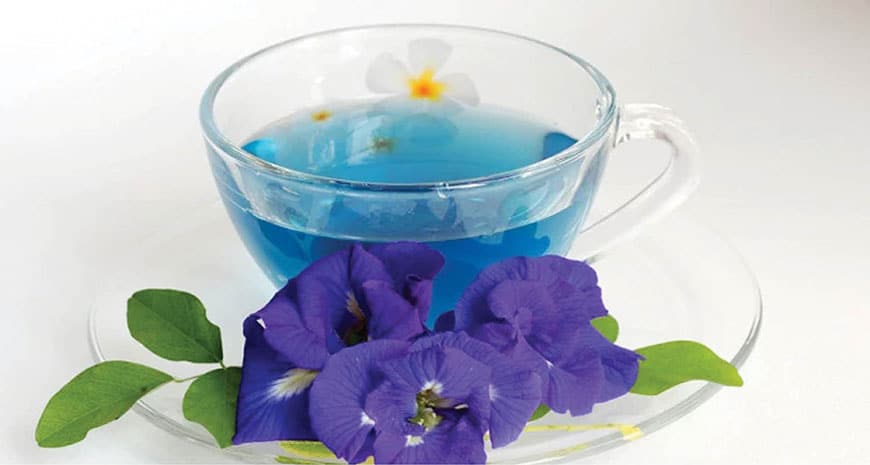
‘Butterfly pea flower tea’
A blue coloured tea full of potent antioxidants is made from the flowers. It is supposed to fight against glycation (protein damage caused by an influx of sugar molecules) and help protect the skin against premature aging.
How to make: Collect a few fresh flowers and put them in a container and add hot water. Shake well and filter the decoction. Blue tea is ready. Cool and add a little lemon juice (optional). Watch the magic, a change from bluish to purple ! Depending on the proportion of lemon juice, colour changes to various shades of blue and purple. Dried lemongrass can also be used along with flowers.
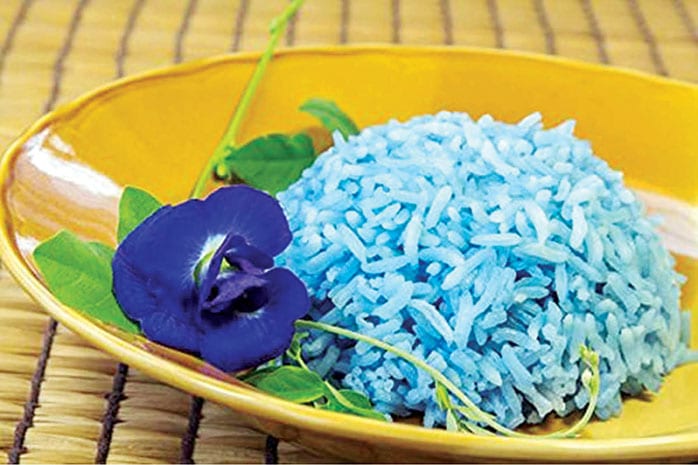
Culinary
Known as ‘Bunga telang’ in Malay the flowers / buds are used as a natural food colouring agent to provide bluish tint to the rice dishes (kuih ketan, nyonya chang and nasi kerabu) in Peranakan / Nyonya cooking. The young pods are edible and used as vegetable in Philippines. Blue tea called ‘Butterfly Pea Flower tea’ (similar to green tea) is prepared from the flowers. In Burmese and Thai cuisines, the flowers are also dipped in batter and fried (like pakodas). The flowers have more recently been used in a colour-changing gin known as Sharish Blue Magic: Blue gin in the bottle turning pink (shimmering blue colour or bluish pink) generated by an infusion of the flower when mixed with a carbonated water due to change in pH.
Useful tips
- A beautiful climber most suitable for fences and trellises.
- Can also be grown in pots with a support.
- Does well in moist, neutral soil — needs no special care.
- Grows best under bright sun though it can be grown in semi-shade areas.
- Water moderately and avoid water-logging.
- Flowers and buds are edible. Collect, dry and store in a dry bottle for future use.
- Propagation: Soak well-dried seeds for 4 hours and directly sow an inch below the soil in pots or desired place. Seeds germinate in 2 weeks time and flowering in another 4 weeks time.
- A N2 fixing plant with nodules present in the roots, it improves soil fertility : hence used as a re-vegetation species.
- Can also be used as a green manure.
- A valuable cover crop in rubber and coconut plantations.
- Can be grown as an inter-crop in agriculture fields for hay and silage for livestock as the plant is highly proteinaceous.
- It attracts various kinds of bees, butterflies and birds.
Uses
It is a multi-utilitarian plant used for food, medicine, dye and animal feed besides ornamentation. However, it is mostly grown as a medicinal herb / ornamental climber in India.
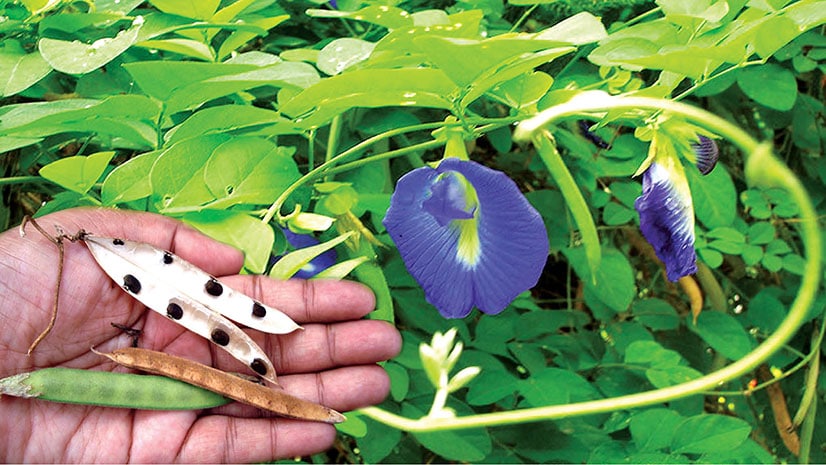
Medicinal values
A native medicinal herb, its root, bark, leaves and seeds are used in ayurvedic preparations. The herb is in use for centuries as a memory enhancer prescribed for children suffering from developmental problems of brain and impaired cognitive function. The plant contains wide range of secondary metabolites like triterpenoids, flavonol glycosides, anthocyanins, steroids and used to treat vata vitiated disorders besides panchakarma treatments for balancing doshas in the body to bring about internal as well as external detoxification. The root is also used for leucoderma.
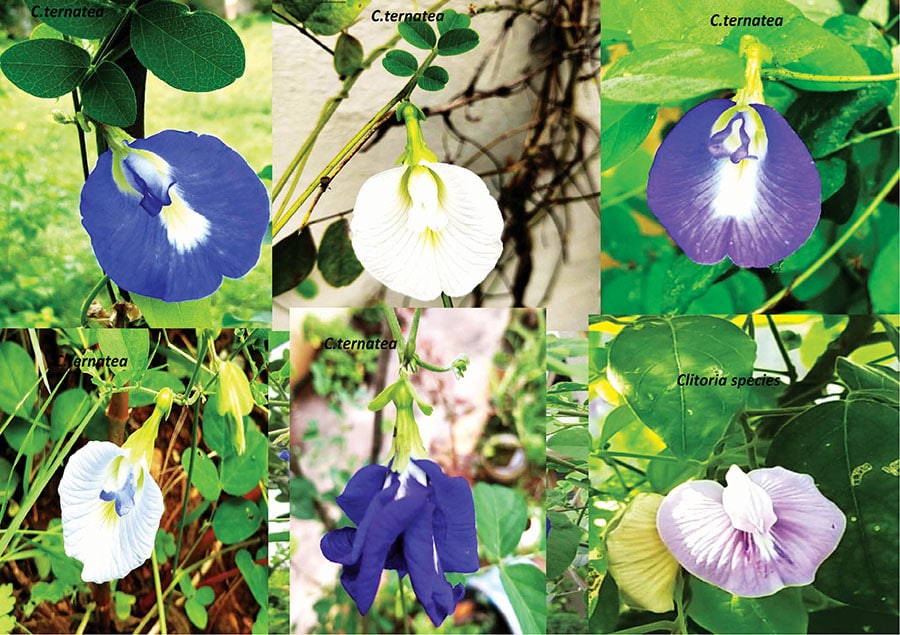
Pasture legume
It is grown for its high-quality, protein-rich legume called “tropical alfalfa” in tropical and subtropical regions of the world.
Mob: 97429-91057 e-mail: [email protected]



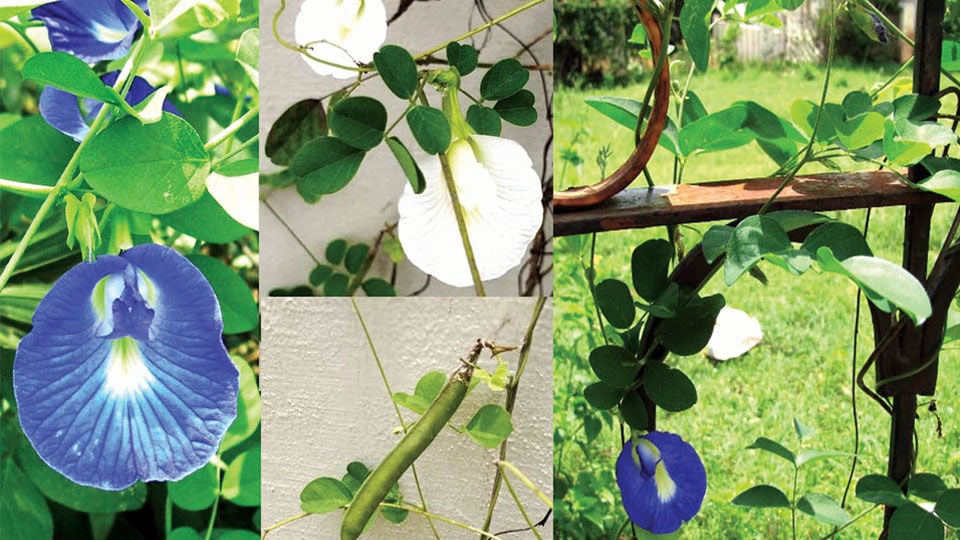



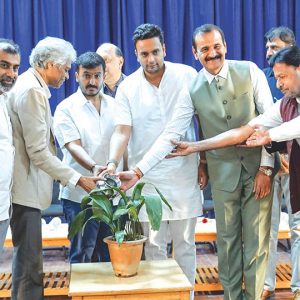
Recent Comments